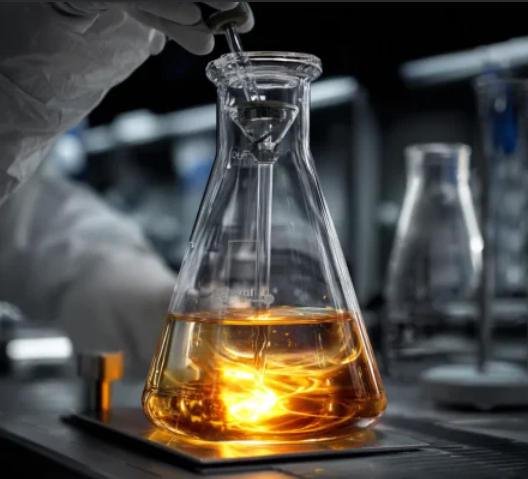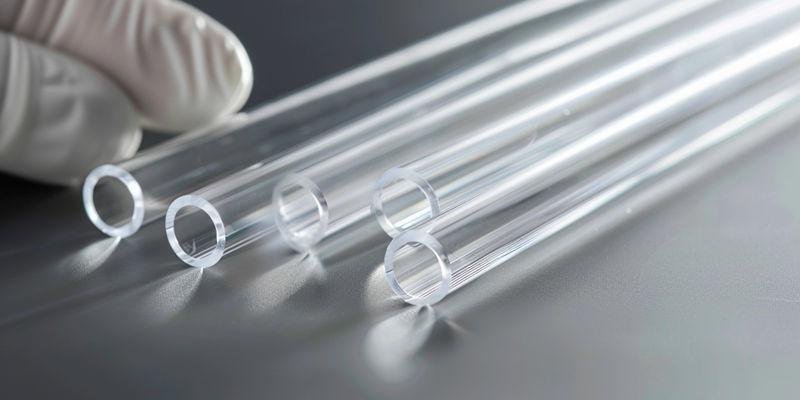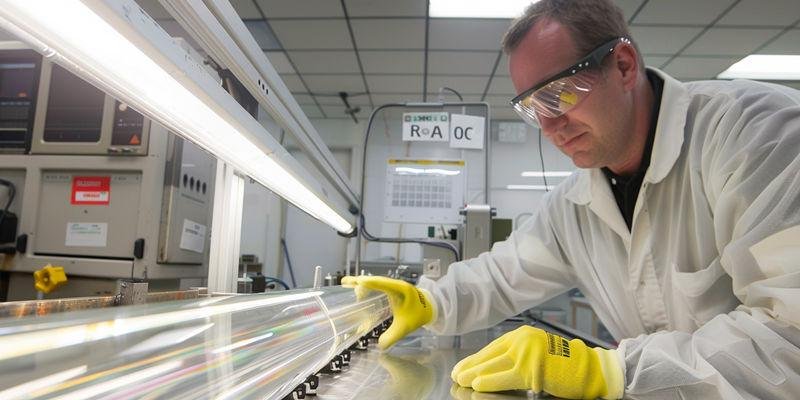You can use a quartz flask safely up to 1200°C. This matches what the 2025 TOQUARTZ Quartz Glass guide says.
Property | Value | Unit |
|---|---|---|
Maximum Working Temperature | 1200 | °C |
This high temperature is possible because quartz has ultra-pure silica. Quartz also has a non-crystalline structure. Fused quartz does not expand much when heated. It stays strong and stable. You can trust quartz for hot reactions in your lab.
Key Takeaways
Quartz flasks can handle heat up to 1200°C for a short time. For long use, keep heat below 1000°C to keep them strong.
High-purity quartz glass, like TOQUARTZ, can take up to 1450°C for a short time. Always check how pure the glass is for better heat safety.
Quartz flasks work well in hot reactions and fight chemicals better than other glass. This makes them great for hard lab work.
Do not change the temperature quickly or cracks may form. Always heat slowly and use good supports to spread heat.
Check your quartz flasks often for cracks or cloudy spots. Replace any flask that is damaged to stay safe during experiments.
Quartz Flask Temperature Limits

Maximum Safe Temperatures
How hot can you use a quartz flask in 2025? You should know the safe limits for short and long use. Quartz glass can handle very high heat. The table below shows the top safe temperatures:
Material | Maximum Safe Temperature | Application |
|---|---|---|
Quartz Glass | Up to 1,200°C | High-temperature reactions, melting |
TOQUARTZ Quartz Glass works even better. Its SiO₂ purity is 99.98%. This lets the flask take up to 1450°C for a short time. For long use, keep the temperature lower. Here are the limits for different purity levels:
SiO₂ Purity Level | Temperature Limit (°C) | Additional Notes |
|---|---|---|
99.98% | 1100 | Good for long use with high stability |
99.98% | 1200 | Handles SO₂ gas in metal work |
99.98% | 1600+ | Great for making chips and industry |
You might ask how long you can heat a quartz flask. For short heating, you can go up to 1200°C. For long use, stay under 1000°C. Here is a quick list:
Short-term max temperature: 1200°C (brief heating)
Long-term max temperature: 1000°C
If you heat quartz flasks for a long time, they can change. This is called devitrification. The flask turns cloudy and gets weaker. Do not keep the flask above 1000°C for a long time. This keeps it strong and safe.
Why Quartz Handles High Heat
Why does quartz do so well with heat? It is because of its special structure and high purity. Quartz glass has very pure silica. It does not have grain boundaries. This makes quartz flasks strong against chemicals and heat.
High-purity quartz glass gives you many benefits:
It does not let heat move through it easily.
It can handle sudden changes in temperature.
It does not bend or soften until very high heat.
Quartz glass melts at about 1670°C. This is much hotter than borosilicate or soda-lime glass. You can use quartz flasks for tough lab jobs. They do not get damaged by chemicals or lose their shape in heat.
Tip: Always check your quartz flask’s purity before using it for high heat. Higher purity means it is safer and stronger.
Do you need a flask for strong acids or bases? Quartz flasks resist chemicals better than most other materials. You can trust them for hot and tough experiments.
Comparing Quartz Flask to Other Lab Glassware
Quartz Flask vs. Borosilicate Glass
It is important to know how glassware handles heat. Quartz flasks can take much more heat than borosilicate glass. The difference is big. Here is a simple table to compare them:
Property | Quartz Flask | Borosilicate Glass |
|---|---|---|
Max Safe Temperature | Over 1,200°C | Up to 500°C |
Thermal Shock Resistance | Excellent | Good |
Chemical Resistance | Very High | High |
Quartz flasks can handle over 1,200°C.
Borosilicate glass can only go up to 500°C.
Quartz flasks are best for very hot experiments. Borosilicate glass is strong but cannot take as much heat. If you need to heat something above 500°C, use a quartz flask.
Did you know? Quartz glassware can handle quick temperature changes better than borosilicate glass. You can move a quartz flask from a hot oven to a cooler place with less chance of breaking.
Common Use Cases
Different glassware is used for different lab jobs. Quartz flasks are great for high heat, melting metals, and strong acids or bases. They are also used in making computer chips and light experiments.
Borosilicate glass is used for mixing, heating below 500°C, and normal lab work. You see it in beakers, test tubes, and flasks for school science.
Use a quartz flask for:
Very hot reactions
UV or light experiments
Strong chemicals
Use borosilicate glassware for:
Mixing and heating every day
Storing samples
Experiments under 500°C
Pick your glassware by thinking about what your experiment needs. If you need the most heat and chemical strength, quartz flasks are the best choice.
Factors Affecting Temperature Performance
Thermal Shock
Have you thought about what happens if you heat a flask too fast? Quartz flasks are very good at handling thermal shock. You still need to be careful with them. Quick temperature changes can stress glassware. This stress can cause cracks or even break the flask. The table below shows how different materials react to sudden temperature changes:
Material Type | Max Survived ΔT (°C) | Typical Failure Mode | ASTM C1525 Test Result |
|---|---|---|---|
Soda-Lime Glass | 60–100 | Cracks/shatters | Fails at low ΔT |
Borosilicate Glass | 150–230 | Partial cracking | Degrades over cycles |
>1000 | No visible failure | Retains properties |
Quartz glassware does much better with big temperature changes. To keep your flask working well, follow these tips:
Change temperature slowly.
Do not heat or cool quickly.
Put your flask on a heat-resistant mat or wire gauze.
Keep glassware away from open flames or heating coils.
Purity and Manufacturing
Do you know why purity is important for your flask? Quartz with high purity, like TOQUARTZ Quartz Glass, works better with heat. Impurities can lower the temperature limit. They also make devitrification happen faster. New ways of making quartz flasks in 2025 have made them stronger and more resistant to chemicals. Labs now use quartz glassware for jobs that need high heat.
Property | Value |
|---|---|
Typical Purity | |
Maximum Working Temperature | ~1200°C (Continuous) |
Low Coefficient of Thermal Expansion | ~0.55 x 10⁻⁶ /°C |
Better material science has made quartz flasks last longer. You get better heat stability and glassware that stays strong.
Wear and Age
Does your flask change as it gets older? Heating and cooling many times can cause small cracks or make the flask cloudy. Devitrification can happen if you use high heat for a long time. Impurities make this happen faster. Check your glassware often for cloudiness or cracks. If you see changes, get a new flask to keep your experiments safe.
Tip: Look at your flask after many uses. Checking often helps you avoid problems in important experiments.
Safe Use Tips for Quartz Flasks
Heating Best Practices
You want your quartz flask to work well when heating. Put your flask on a flat, steady spot before you start. Always use a heat source you can control, like a lab furnace or hot plate. Do not use open flames with quartz flasks. Raise the temperature slowly. Heating too fast can hurt even strong quartz.
Check your flask for cracks or cloudy spots before heating. If you see any problems, pick a different flask. Keep the flask away from metal surfaces while heating. Use wire gauze or ceramic pads to spread heat. This stops some parts from getting hotter than others and keeps your flask safe.
Watch the temperature with a good thermometer while heating. Know the right temperature for your experiment. Set your heater to match what you need. If you must move the flask after heating, let it cool slowly. Cooling too fast can break the flask. Never put a hot flask on something cold or wet.
Clean your flask with gentle cleaners after heating. Do not use strong chemicals that could harm the quartz. Store your flask in a dry, safe spot when you finish heating. These steps help your flask last longer for more experiments.
Safety in 2025 Labs
Labs in 2025 use new tools for heating. You will see digital controllers to set exact heat levels. Some systems watch heating cycles and warn you if it gets too hot. Lab sensors can check heating and send info to your computer.
Lab workers use safety shields near heating spots. Wear gloves that protect from heat when you touch flasks. Safety goggles keep your eyes safe from splashes or quick heat changes. Labs have signs to show heating areas and safe spaces.
Lab managers teach staff how to heat things safely. You can go to workshops to learn safe heating. Labs have screens that show heating tips and reminders. If you have questions, ask your boss or look in the lab manual.
What heating tool do you use most? Tell your team about it. You help keep your lab safe by following heating rules. In 2025, labs use smart heating and teamwork to keep everyone safe during experiments with glassware.
You should know the main temperature limits for TOQUARTZ Quartz Glass flasks. Look at the table for quick facts:
Property | Value |
|---|---|
Maximum continuous use | |
Maximum short-term exposure | 1600°C |
Thermal expansion coefficient | 5.5×10⁻⁷ /°C |
Material | Fused silica (SiO₂ ≥ 99.995%) |
Thermal shock resistance | Exceptional |
Quartz glassware is made with high purity. Strong manufacturing keeps your samples safe. It helps stop contamination and works well with very hot temperatures.
Use these tips in your lab in 2025:
Check flasks for cracks before you use them.
Put on gloves and goggles.
Handle flasks gently and store them safely.
Clean flasks only when they are cool.
Teach your team and keep safety gear close.
What do you do to keep your lab safe when you work with high heat?
FAQ
What is the melting point of quartz glass?
Quartz glass melts at about 1670°C. You should never heat your flask to this temperature in the lab. Always stay below the recommended maximum for safe use.
What makes quartz flasks better for UV experiments?
Quartz flasks let UV light pass through easily. You can use them for experiments with wavelengths from 190 to 4500 nm. This range covers most UV and visible light tests.
What cleaning methods work best for quartz flasks?
Use mild detergents and warm water to clean quartz flasks. Avoid strong acids or bases. Rinse with distilled water for best results. You keep your flask clear and ready for the next experiment.
What signs show a quartz flask needs replacing?
Look for cracks, chips, or cloudy spots. These changes mean your flask may not work safely. Replace it before your next experiment to protect your results.
What temperature monitoring tools should you use with quartz flasks?
Digital thermometers and infrared sensors give you accurate readings. You can track temperature changes quickly. These tools help you keep your flask within safe limits.





